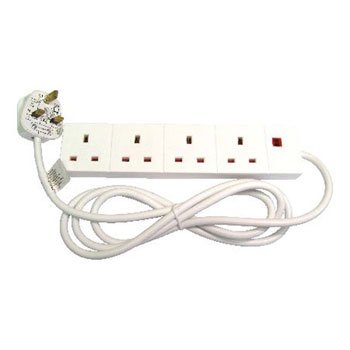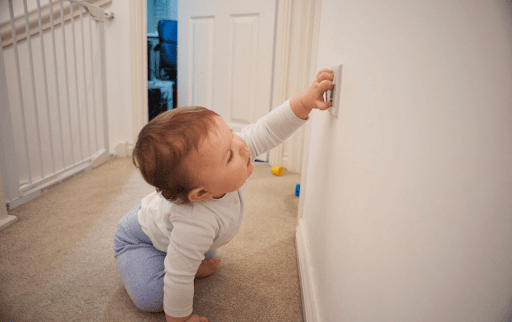Using Plug Sockets Safely at Nursery
When it comes to operating a daycare or nursery, ensuring a safe environment for children is of utmost importance. One aspect of safety that can often be overlooked is the use of electrical outlets.
While outlets are an essential part of any electrical setup, they can also pose a potential hazard if not used correctly.
In this article, we will discuss some important considerations for using electrical outlets safely in a daycare or nursery setting.
Below are the steps you should take to ensure you are using plug sockets safely at nursery.

1. Check the condition of the plug sockets
 Checking the condition of the electrical outlets is an essential step in ensuring the safety of the children in a nursery or other childcare setting. Before plugging any electrical device into an outlet, it’s important to thoroughly inspect the outlet for any signs of damage, such as cracks, breaks, or other forms of damage. This is because damaged outlets can pose a serious electrocution risk, which can result in injuries to children or staff.
Checking the condition of the electrical outlets is an essential step in ensuring the safety of the children in a nursery or other childcare setting. Before plugging any electrical device into an outlet, it’s important to thoroughly inspect the outlet for any signs of damage, such as cracks, breaks, or other forms of damage. This is because damaged outlets can pose a serious electrocution risk, which can result in injuries to children or staff.
Therefore, if you notice any damage to an outlet, it’s crucial to switch off the power to that outlet immediately and call a professional electrician to fix the problem. By taking this precautionary step, you can help prevent potentially hazardous situations from occurring and ensure the safety of all those in your care. This should be done by the PAT testing system.
PAT testing refers to Portable Appliance Testing, which is the process of testing electrical appliances for safety. It involves a visual inspection of the appliance for any damage, followed by testing with specialist equipment to check for electrical faults. This testing is important to ensure the safety of electrical appliances used in the workplace, including nurseries and other childcare settings. PAT testing should be carried out by a qualified professional and should be done regularly to maintain the safety of appliances.
2. Do Not Use Plug Safety Covers
 Using plug socket covers are not recommended in the UK.
Using plug socket covers are not recommended in the UK.
This is because UK sockets already have built-in protection, and some experts consider plastic blank plugs to be more of a danger because they may create a false sense of security.
It also creates a situation whereby children may remove the cover and put the plug cover back in incorrectly, this could then make the plug socket ‘live’ causing a potentially hazardous situation.
However, it is important to note that this is a matter of debate and some sources may still recommend the use of safety covers in certain situations. It is recommended to consult with experts and follow relevant laws and regulations regarding plug socket safety in the UK.
3. Use extension cords safely
 While extension cords can be useful in a daycare or nursery setting, it’s crucial to use them safely to prevent potential hazards. One of the most important safety tips when using extension cords is to avoid overloading them with too many devices. Overloading can cause the cord to overheat, which can lead to electrical fires or other hazards.
While extension cords can be useful in a daycare or nursery setting, it’s crucial to use them safely to prevent potential hazards. One of the most important safety tips when using extension cords is to avoid overloading them with too many devices. Overloading can cause the cord to overheat, which can lead to electrical fires or other hazards.
Additionally, it’s essential to avoid using damaged or frayed cords, as these can pose a risk of electrocution. Any extension cord with visible damage should be replaced immediately.
Another important safety consideration when using extension cords in a daycare or nursery is to avoid creating tripping hazards. This means ensuring that cords are not running across floors or under rugs where they can be easily tripped over.
Instead, cords should be placed in areas where they are out of the way and cannot be accidentally pulled or tripped over. By following these safety tips, you can use extension cords safely in a nursery or other childcare settings and help ensure the safety of the children in your care.
4. Keep plug sockets out of reach
 Keeping electrical outlets out of reach of children is a crucial safety measure in a daycare or nursery setting. Ideally, all outlets should be located at a height that is out of reach of young children. This helps to prevent children from accidentally inserting objects into the outlets, which can cause serious harm or injury.
Keeping electrical outlets out of reach of children is a crucial safety measure in a daycare or nursery setting. Ideally, all outlets should be located at a height that is out of reach of young children. This helps to prevent children from accidentally inserting objects into the outlets, which can cause serious harm or injury.
However, if it’s not possible to locate outlets out of reach, it’s essential to use child-resistant covers to prevent children from accessing them. These covers are designed to prevent young children from inserting objects into the outlets, helping to reduce the risk of electrical hazards.
Additionally, you can consider using furniture or other barriers to block access to electrical outlets. This can include placing bookshelves or other pieces of furniture in front of the outlets or using barriers to create a physical barrier between the children and the outlets.
By taking these measures, you can significantly reduce the risk of electrical hazards and help ensure the safety of children in a nursery or other childcare setting. It’s important to check regularly.
5. Educate staff and parents
 Educating staff and parents on the safe use of electrical outlets is crucial for maintaining a safe nursery environment. By providing training on the proper use of electrical equipment and discussing potential hazards, staff and parents can become better equipped to recognize and prevent electrical hazards from occurring.
Educating staff and parents on the safe use of electrical outlets is crucial for maintaining a safe nursery environment. By providing training on the proper use of electrical equipment and discussing potential hazards, staff and parents can become better equipped to recognize and prevent electrical hazards from occurring.
One aspect of this training should include teaching staff and parents the proper use of extension cords and outlet covers. This includes ensuring that they are not overloaded and are free from any visible damage. Staff and parents should also be encouraged to use outlet covers on unused outlets to prevent young children from accidentally inserting objects into them.
Discussing the potential hazards of damaged outlets and overloaded circuits is crucial. Staff and parents should be trained to recognize the signs of damage, such as cracks, frayed cords, or burn marks, and know what steps to take if they notice any of these issues. Overloaded circuits can also pose a significant risk, and staff and parents should be educated on how to properly distribute electrical loads to prevent overloading.
By educating staff and parents on the safe use of electrical outlets, you can create a safer environment for children in the nursery. It’s essential to regularly review and update this training to ensure that staff and parents are up-to-date with the latest safety guidelines and procedures.
Conclusion
Ensuring the safe use of electrical plug sockets in a nursery and other childcare settings is a critical responsibility for any provider. Electrical hazards can pose a significant risk to children and staff, making it essential to take all necessary precautions to prevent them from occurring.
By following the guidelines outlined in this article, such as checking the condition of sockets, using socket covers, using extension cords safely, keeping sockets out of reach, and educating staff and parents, you can help create a safer environment for children in your care.
These simple steps can significantly reduce the risk of electrical hazards and help ensure the safety and well-being of all children in your nursery or daycare.
FREQUENTLY ASKED QUESTIONS
Q: Why is it important to use plug sockets safely in a nursery setting?
A: Using plug sockets safely in a nursery setting is essential for maintaining a safe environment for children. Electrical hazards, such as electrocution or electrical fires, can cause serious harm or injury to children or staff. Therefore, it’s crucial to take all necessary precautions to prevent these hazards from occurring.
Q: What should I do if I notice a damaged plug socket in a nursery?
A: If you notice a damaged plug socket in a nursery, you should switch off the power to that socket immediately and call a professional electrician to fix the problem. Damaged sockets can pose a serious electrocution risk, so it’s essential to take swift action to prevent any potential harm.
Q: How can I reduce the risk of electrocution in a nursery setting?
A: There are several ways to reduce the risk of electrocution in a nursery setting. One way is to use safety covers on all unused plug sockets to prevent children from accidentally inserting objects into them. It’s also important to ensure that all electrical equipment is in good condition and free from damage, and to avoid overloading extension cords or electrical circuits.
Q: Can I use extension cords in a nursery setting?
A: Yes, extension cords can be used in a nursery setting when necessary. However, it’s crucial to use them safely and to avoid overloading them with too many devices. Additionally, damaged or frayed cords should never be used, as they can pose a risk of electrocution.
Q: What should I do if a child has been electrocuted in a nursery setting?
A: If a child has been electrocuted in a nursery setting, it’s essential to seek medical attention immediately. Call 999 or your local emergency services, and follow any instructions provided by the operator. While waiting for medical attention to arrive, turn off the power to the area where the electrocution occurred and move the child away from any potential hazards.
Q: How can I educate staff and parents on the safe use of plug sockets in a nursery setting?
A: Educating staff and parents on the safe use of plug sockets can include providing training on the proper use of extension cords and safety covers, as well as discussing potential hazards such as damaged sockets and overloaded circuits. This education can be provided through staff training sessions, parent-teacher meetings, or through written materials such as posters or pamphlets. Regular review and updates to this training are also important to ensure that staff and parents are up-to-date with the latest safety guidelines and procedures.



